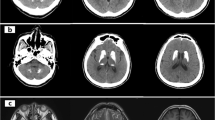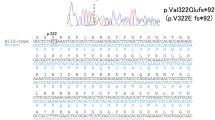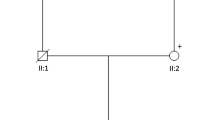Abstract
Familial idiopathic basal ganglia calcification (FIBGC) is an inherited neurodegenerative disorder characterized by the accumulation of calcium deposits in different brain regions, particularly in the basal ganglia. FIBGC usually follows an autosomal dominant pattern of inheritance. Despite the mapping to chromosome 14q of a susceptibility locus for IBGC (IBCG1) in one family, this locus has been excluded in several others, demonstrating genetic heterogeneity in this disorder. The etiology of this disorder thus remains largely unknown. Using a large extended multigenerational Italian family from South Tyrol with 17 affected in a total of 56 members, we performed a genome-wide linkage analysis in which we were able to exclude linkage to the IBCG1 locus on chromosome 14q and obtain evidence of a novel locus on chromosome 2q37.



Similar content being viewed by others
References
Baba Y, Broderick DF, Uitri RJ, Hutton ML, Wszolek ZK (2005) Heredofamilial brain calcinosis syndrome. Mayo Clin Proc 5:641–651
Brodaty H, Mitchell P, Luscombe G et al (2002) Familial idiopathic basal ganglia calcification (Fahr’s disease) without neurological, cognitive and psychiatric symptoms is not linked to the IBGC1 locus on chromosome 14q. Hum Genet 1:8–14
Ellie E, Julien J, Ferrer X (1989) Familial idiopathic striopallidodentate calcifications. Neurology 3:381–385
Geschwind DH, Loginov M, Stern JM (1999) Identification of a locus on chromosome 14q for idiopathic basal ganglia calcification (Fahr disease). Am J Hum Genet 3:764–772
Ishikawa S, Ishikawa M, Tokuda T et al (2000) Japanese family with an autosomal dominant chromosome instability syndrome: a new neurodegenerative disease? Am J Med Genet 4:265–270
Jiao Y, Yan J, Jiao F et al (2007) A single nucleotide mutation in Nppc is associated with a long bone abnormality in lbab mice. BMC Genet 8:16
Kong A, Gudbjartsson DF, Sainz J et al (2002) A high-resolution recombination map of the human genome. Nat Genet 3:241–247
Lopez-Villegas D, Kulisevsky J, Deus J et al (1996) Neuropsychological alterations in patients with computed tomography-detected basal ganglia calcification. Arch Neurol 3:251–256
Moskowitz MA, Winickoff RN, Heinz ER (1971) Familial calcification of the basal ganglions: a metabolic and genetic study. N Engl J Med 2:72–77
Oliveira JR, Lemos RR (2009) Linkage studies in familial idiopathic basal ganglia calcification: separating the wheat from the chaff. Am J Med Genet B Neuropsychiatr Genet 4:594–595 author reply 593
Oliveira JR, Spiteri E, Sobrido MJ et al (2004) Genetic heterogeneity in familial idiopathic basal ganglia calcification (Fahr disease). Neurology 11:2165–2167
Oliveira JR, Sobrido MJ, Spiteri E et al (2007) Analysis of candidate genes at the IBGC1 locus associated with idiopathic basal ganglia calcification (“Fahr’s disease”). J Mol Neurosci 2:151–154
Ozand PT, Gascon GG, Al Essa M et al (1998) Biotin-responsive basal ganglia disease: a novel entity. Brain 7:1267–1279
Pattaro C, Marroni F, Riegler A et al (2007) The genetic study of three population microisolates in South Tyrol (MICROS): study design and epidemiological perspectives. BMC Med Genet 1:29
Price PA, Nguyen TM, Williamson MK (2003) Biochemical characterization of the serum fetuin–mineral complex. J Biol Chem 24:22153–22160
Sambrook J, Fritsch EF, Maniatis T (1989) Molecular cloning: a laboratory manual. Cold Spring Harbor Laboratory Press, New York
Sobel E, Lange K (1996) Descent graphs in pedigree analysis: applications to haplotyping, location scores, and marker-sharing statistics. Am J Hum Genet 6:1323–1337
Tominaga M, Kurihara H, Honda S, Amakawa G, Sakai T, Tomooka Y (2006) Molecular characterization of mitocalcin, a novel mitochondrial Ca2+-binding protein with EF-hand and coiled-coil domains. J Neurochem 1:292–304
Volpato CB (2008) Letter to the editor in response to: “Linkage Studies in Familial Idiopathic Basal Ganglia Calcification: Separating the Wheat from the Chaff” by Oliveira et al. Am J Med Genet B Neuropsychiatr Genet. 2009 Jun 5;150B(4):594–5. Am J Med Genet B Neuropsychiatr Genet 4:593
Volpato CB, De Grandi A, Buffone E et al (2008) Exclusion of linkage to chromosome 14q in a large South Tyrolean family with idiopathic basal ganglia calcification (IBGC). Am J Med Genet B Neuropsychiatr Genet 7:1319–1322
Zeng WQ, Al-Yamani E, Acierno JS Jr et al (2005) Biotin-responsive basal ganglia disease maps to 2q36.3 and is due to mutations in SLC19A3. Am J Hum Genet 1:16–26
Acknowledgments
The authors gratefully acknowledge the contribution of all the study participants and their family members; without their cooperation, this work would have not been possible. We thank Sara Pedrotti, Clemens Egger, Yuri D’Elia, and Donatella Brunelli for the technical support. The study was supported by the Ministry of Health of the Autonomous Province of Bolzano and the South Tyrolean Sparkasse Foundation.
Author information
Authors and Affiliations
Corresponding author
Additional information
The Institute of Genetic Medicine, European Academy Bozen/Bolzano (EURAC) is an affiliated institute of the University of Lübeck, Germany.
Electronic Supplementary Material
Below is the link to the electronic supplementary material.
Figure S3
Results of the genome-wide scan for each chromosome. The dotted line represents the location score for the parametric analysis using affected only. The solid black line represents the location score for the parametric analysis, while the dashed line represents −log10(p value) for the NPL_Pair score statistic. Genetic distance is based on the deCODE Genetic map. Strongest evidence for linkage was at two positions in the genome, at 2q37 (LOD = 2.44 at marker D2S2973) and 11p15.4 (LOD = 3.63 at marker D11S1760). This linkage was shown to be an artifact due to a noninformative marker flanking D11S1760. Once the analysis was repeated after removing the problem marker close to D11S1760 and after further genotyping the marker at this locus, the signal at 11p15 decreased to LOD = −3.04. Haplotype analysis shows that allele 6 (the most frequent in the population) at D11S1760 is present in all of the affected individuals but also in 14 individuals of unknown status and in one healthy.
Rights and permissions
About this article
Cite this article
Volpato, C.B., De Grandi, A., Buffone, E. et al. 2q37 as a Susceptibility Locus for Idiopathic Basal Ganglia Calcification (IBGC) in a Large South Tyrolean Family. J Mol Neurosci 39, 346–353 (2009). https://doi.org/10.1007/s12031-009-9287-3
Received:
Accepted:
Published:
Issue Date:
DOI: https://doi.org/10.1007/s12031-009-9287-3




